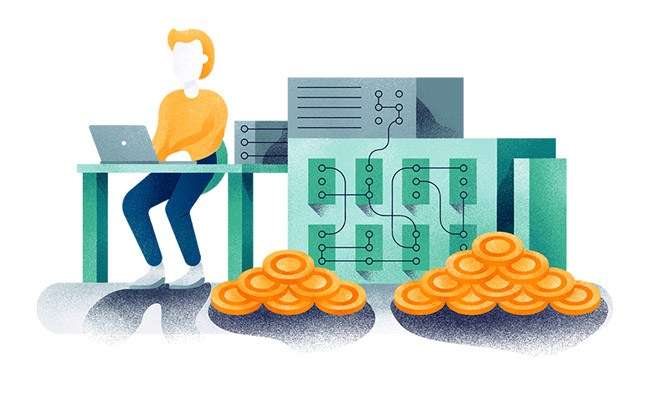There are a variety of different tokens or coins in the cryptocurrency ecosystem. Probably the most well-known are what are known as currency tokens, which act as a store of value and a means of payment. Bitcoin is the most well known of the currency type coins.
The second most used and known token type are the utility tokens. These differ from currency tokens in that they are used to grant holders access to the services or products in a particular network or platform. They are typically multi-functional and work as part of a blockchain. The most well known utility token by far is Ethereum.
Next are securities tokens, which promise an appreciation in value, although they can have other functions. The fact that these tokens offer appreciation is what’s led to the Securities and Exchange Commission in the U.S. to label crpytocurrencies as securities. A security token not only has the potential to increase in value, it also has the potential to offer passive income in the form of dividends.
What about Dividend Tokens
While not all security tokens can be classified as dividend tokens, there are some that are already paying out some portion of profits to holders of the token, which makes them dividend tokens. In essence, they are similar to dividend bearing stocks that pay a portion of the company’s profits to shareholders on a regular basis.
Really, almost all tokens, with the exception of currency tokens, have some potential for passive income. It can’t always be categorized as dividend income though, since dividends are paid out from the profits made by an organization. Other passive income can come from price appreciation, mining operations, and staking.
Tokens that have dividend features may or may not confer voting rights to holders. This is similar to dividend bearing stocks. Unlike stocks, holders of a dividend paying cryptocurrency can collect the passive income, but holding the coins doesn’t convey any ownership in the organization that issues the coins.
It’s interesting to note that the staking available with Proof of Stake coins is similar to dividends, and most people might consider these to be dividend tokens. There are certainly similarities.
With staking tokens and other dividend paying tokens the payouts may be regular, for example quarterly, monthly, weekly, or even daily. The payments might also be dependent of a minimum level of token ownership, with large holders receiving payment priority. This is similar to preferred stocks in the equity markets. The dividend payments might also depend on the issuer reaching certain milestones in development or performance.
How Utility Tokens Differ from Security Tokens

Image credits:
Utility tokens are not always created with profits in mind. Thanks to blockchain technology and the rise of decentralization in networking it’s now possible to create entire networks and platforms on top of a blockchain. It’s utility tokens that make it possible for users to transact on the blockchain, trading units of blockchain value. These units might be representations of services or products, or they might grant access to certain network components, or they could be a reward for contributions, or they might just be a different form of monetary value.
By contrast a securities token has one goal and that’s profits. And one form of profits offered by a securities token is the promise of future passive income. In the cases where tokens “emphasize the potential for profits based on the entrepreneurial or managerial efforts of others” they can be viewed as securities, as interpreted by the SEC.
By contrast, utilities tokens aren’t a representation of an investment or the potential for profits.
Of course it is important to note here that this definition of a securities token is based on U.S. interpretation. There’s no uniformly accepted definition currently, and you’ll find that the classification of cryptoassets varies widely between countries and industries.
Why Dividend Income is Superior
Quite simply it’s because it is passive income.
There are many passive income strategies, but dividend income is undeniably the best of them all.
When you receive passive income it means you’re getting regular, recurring payments for work you’ve done in the past. There’s no need to do any additional work and the dividends continue paying you. Dividend tokens work in the same way. Another beneficial feature of dividends is that they will typically continue even in a bear market, where the value of most of your assets could be shrinking.
On good example in the crypto-sphere is Nexo.io, a company that provides instant cryptocurrency backed loans. The company’s website proclaims it is the “first SEC-compliant dividend paying, asset backed security token”.
30% of the company’s profits are currently being paid as dividends to token holders each month. The dividend payments are made in ETH.
The idea of dividend yielding assets certainly isn’t a new concept. Cryptocurrencies have borrowed the concept from the equity markets, where investors often receive dividends from various shares. It’s not unknown for an investor to recover all of their initial investment in a stock simply by collecting dividends over time. This can happen even if the price of the stock remains fairly fixed. Dividends can even increase over time, making this type of passive income even more powerful.
And don’t forget about compounding and the power it holds. Taking dividends and reinvesting them in the asset, when combined with asset appreciation, will take your passive income to stellar levels. This combination has the potential to repay the initial investment several times over in just several years time in some cases.
In our world of ultra-low interest rates having a portfolio of dividend paying stocks and cryptocurrencies can be a game-changer for your wealth creation plans.
Regulations for Dividend Tokens

Image credits:
In the U.S. dividend bearing cryptocurrencies are classified as securities. The regulation of dividend bearing tokens around the world varies from country to country, and is very much a grey area.
Regulators have been hard pressed to create a regulatory framework for cryptocurrencies, since they differ from traditional assets, and can also fill a variety of roles, as we’ve already seen. The fact that buyers of cryptocurrencies acquire any number of intangible products, services, rights and value has seen some regulators become too heavy handed, while others are remaining on the sidelines until they either have a better understanding, or until the space matures further.
The SEC in the U.S. has decided to classify all cryptocurrencies that promise any future profits as securities. They are unconcerned if the coin or token could be considered a security token, a utility token or any other token type.
Dividend tokens, as far as they offer investors a possibility to generate a passive income, fall under the same classification as securities, at least as far as US legislation is concerned.
European countries seem to be taking a laissez-faire approach for the time being, and many countries have no regulations or taxation where cryptocurrencies are concerned. The Netherlands and Denmark are two good examples of government regulators remaining on the sidelines regarding cryptocurrencies.
Advantages of Dividend Tokens
Again I have to come back to passive income as the top advantage of dividend tokens. An additional advantage is the simplicity of dividend tokens. So many tokens have restrictions as o how they can be used, minimum amounts needed, and restrictions on networks. But dividend tokens are a straightforward passive income model.
This is a benefit for holders in jurisdictions where cryptocurrencies are regulated as it provides transparency and security which can’t be found in most asset classes. As blockchain assets the dividend tokens are also decentralized, and in some cases they can even be anonymous.
Of course to continue paying dividends the organizations behind the tokens need to remain profitable. And that’s actually an advantage because all the organizations that commit to paying dividends have profitability as one of the major goals, which can give investors increased certainty regarding the value of their holdings.
Downsides to Dividend Tokens
Payouts from dividend bearing tokens are not always predictable, and this is definitely a disadvantage. In addition, the issuer can make changes to the dividend plan without input from any other source.
In some cases dividends are only distributed once an individual reaches a given level in tokens or transactions. This might be done to avoid transaction costs, or to maximize payout amounts. The organizations that give priority to the holders of large amounts of tokens might not be suitable for smaller holders.
And in some cases the dividend payout may depend on the organization reaching certain milestones or performance goals, which is out of the control of the investors.
How Dividend Tokens are Best Used
When looking at enterprises who might distribute dividend tokens the cryptocurrency exchanges are already breaking into that area, with KuCoin being a prime example. Cryptocurrency investment funds could also issue dividend tokens as a means of distributing any profits made from their investments. Of course the company looking to reward token holders by distributing their profits is the most classic example. And mining companies might also be a good way to use dividend tokens to share some of the mining profits with token holders.
Those are just a few examples. In reality dividend tokens have limitless applications, thanks to their versatility and flexibility. As the cryptocurrency ecosystem continues expanding we’ll likely see dividend tokens used in unusual places that were never thought of previously.
From a user perspective, dividend tokens serve to provide returns for users who choose to hold a particular coin or token. This way users can enjoy current income as well as growth in the value of their cryptocurrency holdings.
Dividend tokens are an excellent asset to hold as most not only provide passive income, but they are also quite liquid. As a digital financial asset they can best be used as part of a financial plan or as some type of investment strategy.
In Conclusion
Dividend tokens could provide a solution to a growing problem in cryptocurrencies. With so many cryptocurrencies to choose from, and the regulatory problems that overhang the asset class, many cryptocurrencies go unused, even though the project behind them is a solid one. This problem will only grow, with crypto platform Latoken estimating that by 2025 crypto wallet penetration will reach 5% of the world’s population. With this penetration they estimate the market capitalization of cryptocurrencies will reach $5 trillion.
While this growing wallet usage and market capitalization is certainly positive for the industry as a while, the increased volume could be limited to mostly the top coins and tokens, further isolating smaller issues that don’t provide some additional value to investors. Dividend tokens could be the answer to under-utilization of tokens, as it would provide liquid cash in the form of a dividend, giving investors an incentive to buy and hold dividend tokens.
Welcome to the new conservative investment strategy!
Featured image